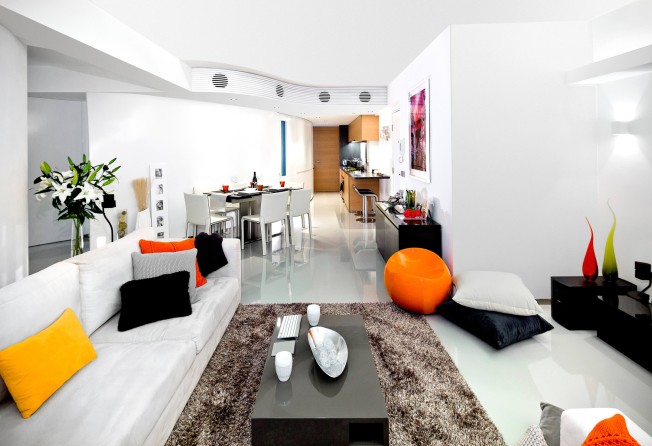
Bending the rules
Learning to live with rounded walls is nothing if not a learning curve


Text Charmaine Chan / Styling David Roden / Photography John Butlin
It’s always an exercise fraught with uncertainty when you bring together an architect and his end user for the first time. Will they gel?
What will be said? Who will be right?
So it was when tenant Amit Patel met Anderson Lee, of Index Architecture, in the former’s home on Conduit Road, Mid- Levels, last month. Having lived in the 1,400 sq ft flat for just over a year, the banker was keen to praise the things he liked about the property … but also have a dig at aspects of it that gave him grief.
Patel, who last year returned to Hong Kong from Britain after living here for three years in the late 2000s, viewed 60 apartments before deciding on the one designed by Lee. But it wasn’t an immediate decision to rent the property. He – like many other interested parties, according to the estate agent – was attracted to, but also worried by, the curved walls, the apartment’s outstanding feature.
How to fit furniture into the space was the main concern.
That’s not to say Patel wasn’t impressed, though.
“I walked into this place and loved it,” says Patel, who signed the lease two days after viewing the flat, having decided he’d put his existing furniture in storage and have everything made to fit his new home. “It was different; something I’d never seen before.”
Lee had based his curvy ideas on Finland’s Kiasma, a museum in Helsinki that he helped design years ago while working for Steven Holl in New York. His plan for the flat, owned by a client who bought it as an investment, was to create room dividers that weren’t so much walls as art. The apartment, which comes with a shared rooftop, had a typical layout: three bedrooms off a central corridor, two bathrooms and a closed kitchen.
“All my client requested was something cool and modern,” Lee says. “She also wanted to maintain the basic layout.
“One of the first things I thought was, ‘Is there a way to break out of the box?’ … to dissolve all of these orthogonal walls so that the corridor almost disappears.”
In creating walls more curvaceous than any Bond girl, he has, he says, created “moments” he loves.
The result is a space the three bedrooms share outside their doors that feels wider and less enclosed than before.
Patel readily acknowledges the pleasing effect of the walls but says they have also made the purchase and placement of furniture a headache – especially in the area between the lounge and kitchen, which Lee opened to create one large living zone.
Initially, Patel – who lives in the flat with his girlfriend – wanted a round dining table but feared it would obstruct movement between the living area and the bedrooms.
“In the end I found a retractable [rectangular] table that was kind of the right size,” he says.
Lee isn’t surprised to hear of Patel’s challenges in his search for furniture and reveals that a built-in, pivoting curved table he had designed for the space was shelved because of his client’s fear it might turn away potential tenants who wanted greater layout flexibility.
The curved walls also prevented Patel from hanging art: nothing sits flat on them so they’ve been left bare.
Lee, for his part, says designing the flat was a strange experience.
“We didn’t know who would want to live here. A couple? People with kids? A bachelor? And it had to be minimal, but with some kind of uniqueness to it.”
He has, undoubtedly, met that brief.
He adds: “It takes a certain individual to like this apartment and to use their creativity to inhabit the space.”
In Patel, it seems as though he has found his ideal end user.

Kitchen The kitchen, which was opened up to the living area by architect Anderson Lee of Index Architecture (2/F, Kam Ling Court Commercial Centre, 532 Queen’s Road West, Sheung Wan, tel: 2155 1007), was built for about HK$100,000 by Shing Yip Services (12/F, Block 1, Golden Dragon Industrial Centre, 152 Tai Lin Pai Road, Kwai Chung, tel: 3427 5138).
Kitchen nook Breakfast is taken informally at the “bar”, which is an extension of the kitchen counter. The stools (HK$1,500 each) were from SofaSale (2/F, Tung Kin Factory Building, 196 Tsat Tsz Mui Road, Quarry Bay, tel: 2541 1230).

Dressing room Wardrobes have been built against one of two curved walls in the dressing room. The door to the room, like those elsewhere in the flat, had to be built on-site to ensure a precise curve and flush fit. The grey cube was HK$2,000 at Indigo Living.
Curved walls The curved walls “dissolve” the rigidness of the corridor, providing moments of beauty.

A breath of fresh air The internal window, made with acid-frosted, tempered glass, allows in air and light. The glass, which is part of the door to the storage room, was set a couple of centimetres away from the window cavity, allowing an opening around it through which air can flow.





